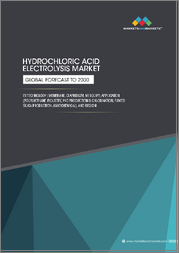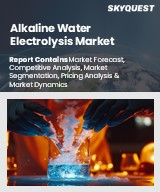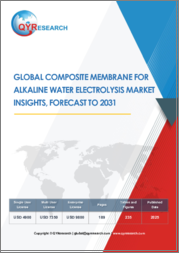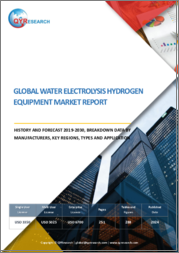
|
시장보고서
상품코드
1477379
세계의 물 전해 시장 - 산업 규모, 점유율, 동향, 기회, 예측(2019-2029년)Water Electrolysis Market - Global Industry Size, Share, Trends, Opportunity, and Forecast, Segmented By Type, By Application, By Region and Competition, 2019-2029F |
||||||
세계의 물 전해(Water Electrolysis) 시장은 2023년에 44억 2,000만 달러로 평가되었으며, 2029년까지 CAGR은 4.31%로 예측 기간에 강력한 성장이 예측됩니다.
풍력발전이나 태양광발전과 같은 재생가능에너지의 이용이 증가하고 있는 것이 세계의 물 전해 시장을 추진하고 있는 주요 요인입니다. 전해는 특히 재생가능에너지의 보급률이 높은 지역에서 잉여재생에너지의 변환과 저장에 중요한 역할을 합니다. 재생가능에너지원의 잉여전력을 전기분해에 의한 수소제조에 활용함으로써 잉여에너지를 저장하고 발전, 수송, 공업공정 등 다양한 분야에서 활용할 수 있어 송전망의 안정성과 유연성을 높일 수 있습니다.
| 시장 개요 | |
|---|---|
| 예측 기간 | 2025-2029년 |
| 2023년 시장 규모 | 44억 2,000만 달러 |
| 2029년 시장 규모 | 56억 3,000만 달러 |
| CAGR 2024-2029년 | 4.31% |
| 급성장 부문 | 알칼리 전해조 |
| 최대 시장 | 유럽 |
탈탄소화와 저탄소 에너지 시스템으로의 전환에 대한 관심 증가는 물 전해에 의해 생성되는 그린 수소 수요를 촉진합니다. 재생가능한 전력을 사용하여 생산되는 그린 수소는 수증기 메탄 개질과 같은 전통적인 방법을 대체하는 탄소 중립적인 옵션을 제공합니다. 정부와 산업계가 세계적으로 야심적인 이산화탄소 감축 목표를 세우고 기후 변화를 추진하고 있기 때문에 녹색수소 수요가 확대될 것으로 예상되며 물 전해 시장 확대를 견인합니다.
전해조 기술 진보와 재생가능 에너지의 비용 저하가 물 전해 시스템의 상업적 실현성을 높이고 있습니다. 제조업체는 전해기술의 효율성, 신뢰성, 확장성을 높이기 위한 연구개발에 투자하고 있으며 기존의 화석연료 기반 공정에 대한 경쟁력을 높이고 있습니다. 태양광 발전과 풍력 발전과 같은 신재생에너지원의 비용 절감은 전해에 의한 수소 제조 비용 전체를 낮추고 시장 성장을 더욱 자극합니다.
신재생에너지와 수소기술의 촉진을 목적으로 한 정부의 지원 정책과 인센티브도 물 전해 시장 성장에 기여합니다. 각국의 정부는 전해 시스템과 그린 수소 인프라의 개발·전개를 촉진하기 위해 보조금, 세제 우대 조치, 규제 틀 등 다양한 시책을 실시했습니다. 이러한 정책은 전해 프로젝트에 대한 투자를 촉진하고 물 전해 기술 채택을 촉진하기 위해 정부, 산업계 및 연구 기관의 협력을 촉진합니다.
주요 시장 성장 촉진요인
전력 산업 성장
기술진보 급증
주요 시장 과제
재생 가능 에너지의 가용성
주요 시장 동향
그린 수소에 대한 관심 증가
부문별 인사이트
유형별 인사이트
용도별 인사이트
지역별 인사이트
목차
제1장 개요
제2장 조사 방법
제3장 주요 요약
제4장 세계의 물 전해 시장에 대한 COVID-19의 영향
제5장 세계의 물 전해 시장 전망
- 시장 규모 및 예측
- 금액별
- 시장 점유율 및 예측
- 유형별(알칼리 전해조, 프로톤 교환막(PEM) 전해조, 고체 산화물 전해조 셀(SOEC), 음이온 교환막(AEM) 전해조)
- 용도별(정제산업, 전력 및 에너지 저장, 암모니아 제조, 메탄올 제조, 수송·모빌리티 산업, 기타)
- 지역별
- 기업별(2023년)
- 시장 맵
제6장 아시아 태평양의 물 전해 시장 전망
- 시장 규모 및 예측
- 금액별
- 시장 점유율 및 예측
- 유형별
- 용도별
- 국가별
- 아시아 태평양 : 국가별 분석
- 중국
- 인도
- 호주
- 일본
- 한국
제7장 유럽의 물 전해 시장 전망
- 시장 규모 및 예측
- 금액별
- 시장 점유율 및 예측
- 유형별
- 용도별
- 국가별
- 유럽 : 국가별 분석
- 프랑스
- 독일
- 스페인
- 이탈리아
- 영국
제8장 북미의 물 전해 시장 전망
- 시장 규모 및 예측
- 금액별
- 시장 점유율 및 예측
- 유형별
- 용도별
- 국가별
- 북미 : 국가별 분석
- 미국
- 멕시코
- 캐나다
제9장 남미의 물 전해 시장 전망
- 시장 규모 및 예측
- 금액별
- 시장 점유율 및 예측
- 유형별
- 용도별
- 국가별
- 남미 : 국가별 분석
- 브라질
- 아르헨티나
- 콜롬비아
제10장 중동 및 아프리카의 물 전해 시장 전망
- 시장 규모 및 예측
- 금액별
- 시장 점유율 및 예측
- 유형별
- 용도별
- 국가별
- 중동 및 아프리카(MEA) : 국가별 분석
- 남아프리카
- 사우디아라비아
- 아랍에미리트(UAE)
제11장 시장 역학
- 성장 촉진요인
- 과제
제12장 시장 동향 및 발전
- 최근 동향
- 제품 출시
- 인수합병
제13장 세계의 물 전해 시장 : SWOT 분석
제14장 Porter's Five Forces 분석
- 업계 내 경쟁
- 신규 진입의 가능성
- 공급자의 힘
- 고객의 힘
- 대체품의 위협
제15장 PESTLE 분석
제16장 경쟁 구도
- Asahi Kasei Corporation
- Nel ASA
- thyssenkrupp AG
- Cummins Inc.
- Toshiba Energy Systems & Solutions Corporation
- Teledyne Technologies Incorporated
- Suzhou Green Hydrogen Energy Co., Ltd.
- ITM Power PLC
- Clean Power Hydrogen plc
- Plug Power Inc.
제17장 전략적 제안
제18장 회사 소개 및 면책 사항
LYJGlobal Water Electrolysis Market was valued at USD 4.42 billion in 2023 and is anticipated to project robust growth in the forecast period with a CAGR of 4.31% through 2029. The increasing utilization of renewable energy sources like wind and solar power is a key factor propelling the global water electrolysis market. Electrolysis plays a vital role in converting and storing surplus renewable energy, especially in regions with high renewable energy penetration. By leveraging excess electricity from renewable sources for hydrogen production through electrolysis, surplus energy can be stored and utilized across various sectors such as power generation, transportation, and industrial processes, thereby enhancing grid stability and flexibility.
| Market Overview | |
|---|---|
| Forecast Period | 2025-2029 |
| Market Size 2023 | USD 4.42 Billion |
| Market Size 2029 | USD 5.63 Billion |
| CAGR 2024-2029 | 4.31% |
| Fastest Growing Segment | Alkaline Electrolyzer |
| Largest Market | Europe |
The growing focus on decarbonization and the transition to low-carbon energy systems is fueling demand for green hydrogen generated via water electrolysis. Green hydrogen, produced using renewable electricity, offers a carbon-neutral alternative to conventional methods like steam methane reforming. With governments and industries globally setting ambitious carbon reduction goals and addressing climate change, the demand for green hydrogen is anticipated to escalate, driving the expansion of the global water electrolysis market.
Advancements in electrolyzer technologies and the decreasing costs of renewable energy are bolstering the commercial feasibility of water electrolysis systems. Manufacturers are investing in research and development to enhance the efficiency, reliability, and scalability of electrolysis technologies, making them more competitive against traditional fossil fuel-based processes. The declining costs of renewable energy sources such as solar and wind power are lowering the overall hydrogen production costs through electrolysis, further stimulating market growth.
Supportive government policies and incentives aimed at promoting renewable energy and hydrogen technologies are also contributing to the growth of the global water electrolysis market. Governments worldwide are implementing various measures like subsidies, tax incentives, and regulatory frameworks to facilitate the development and deployment of electrolysis systems and green hydrogen infrastructure. These policies are fostering investments in electrolysis projects and encouraging collaboration among governments, industries, and research institutions to expedite the adoption of water electrolysis technology.
Key Market Drivers
Growth in Power Industry
The rapid expansion of renewable energy sources like wind and solar power stands as a primary catalyst propelling the global water electrolysis market forward. With nations worldwide committing to ambitious targets for reducing greenhouse gas emissions and addressing climate change, the deployment of renewable energy technologies has surged. Wind and solar power, in particular, have experienced exponential growth, fueled by declining costs, technological advancements, and supportive governmental policies.
Water electrolysis plays a pivotal role in facilitating the integration of renewable energy into the power grid. Electrolyzers can harness surplus electricity generated by wind and solar farms during periods of low demand to produce hydrogen via electrolysis. This green hydrogen can then be stored and utilized as a clean energy carrier for diverse applications, spanning power generation, transportation, and industrial processes. As the proportion of renewable energy in the energy mix continues to rise, the demand for water electrolysis systems to yield green hydrogen is poised to skyrocket, propelling market expansion.
The burgeoning power sector is fueling investments in electrolysis projects and infrastructure development. Power firms are increasingly investing in electrolysis facilities and hydrogen production plants to leverage surplus renewable energy and facilitate grid stabilization. Partnerships between power entities, electrolyzer manufacturers, and research institutions are fostering innovation in electrolysis technologies, driving the creation of more efficient and economically viable electrolysis systems.
The transition toward decarbonizing the power sector is generating fresh avenues for water electrolysis. As power entities aim to shrink their carbon footprint and adhere to stringent environmental regulations, hydrogen generated through electrolysis emerges as a clean and sustainable substitute for traditional fossil fuel-based power generation. The escalating adoption of hydrogen as a power generation fuel, coupled with advancements in electrolysis technologies, is steering the expansion of the global water electrolysis market.
Surge in Technological Advancements
Technological progress has spurred the emergence of advanced electrolysis technologies like proton exchange membrane (PEM) electrolysis and solid oxide electrolysis cells (SOECs). These innovations boast heightened energy efficiency, swifter response times, and enhanced durability compared to conventional alkaline electrolysis methods, rendering them more appealing for commercial use. PEM electrolysis is gaining momentum due to its capability to operate at elevated current densities and lower temperatures, resulting in diminished energy consumption and augmented rates of hydrogen production.
Innovations in materials science and engineering have yielded more resilient and enduring electrolysis components, encompassing catalysts, membranes, and electrodes. These breakthroughs have elongated the lifespan of electrolysis systems, reducing maintenance expenses and downtime while enhancing overall system dependability. Enhanced durability is indispensable for commercial electrolysis applications, where uninterrupted operation and minimal upkeep are imperative.
Technological advancements have facilitated the integration of water electrolysis systems with renewable energy sources like solar and wind power. These systems can now dynamically adapt their operations to match the fluctuating output of renewable energy sources, optimizing energy utilization and bolstering grid stability. The fusion of water electrolysis with renewable energy sources enables the generation of "green hydrogen," characterized by minimal carbon footprint, which can aid in decarbonizing diverse sectors such as transportation, industry, and power generation.
Key Market Challenges
Availability of Renewable Energy
One of the primary hurdles related to utilizing renewable energy for water electrolysis lies in the intermittent nature of renewable energy sources such as solar and wind power. Unlike conventional power sources like coal or natural gas, which offer a consistent and dependable electricity supply, renewable energy sources are subject to external factors like weather conditions and time of day. This intermittency can result in fluctuations in power generation, posing challenges in maintaining steady electrolysis operations and hydrogen production.
Another challenge stems from the disparity between the availability of renewable energy and the demand for hydrogen. In numerous regions, renewable energy generation may surpass demand at certain times, leading to energy curtailment or wastage. There may be instances where renewable energy supply falls short of meeting demand, thereby limiting the availability of clean electricity for water electrolysis. Achieving a balance between renewable energy supply and hydrogen demand to optimize the utilization of electrolysis systems presents a logistical and technical obstacle for stakeholders across the hydrogen value chain.
The integration of renewable energy sources into existing electrical grids and infrastructure introduces further complexities for the water electrolysis market. Grid integration necessitates the implementation of smart grid technologies, energy storage solutions, and grid stabilization mechanisms to manage fluctuations in renewable energy output and ensure grid reliability. The availability of infrastructure for transporting renewable energy from generation sites to electrolysis facilities may be constrained, particularly in remote or underserved areas.
Key Market Trends
Growing Focus on Green Hydrogen
The electrolyzer technology market is experiencing rapid evolution, characterized by efforts to boost efficiency, trim costs, and enhance scalability. Innovative designs like proton exchange membrane (PEM) and alkaline electrolyzers are gaining traction, particularly for their capacity to operate effectively alongside renewable energy sources.
The increasing emphasis on green hydrogen as a sustainable energy carrier is poised to drive substantial growth in the global water electrolysis market in the foreseeable future. Critical factors such as technological breakthroughs, supportive governmental policies, market incentives, and collaborative ventures are set to fuel market expansion, accelerating the shift towards a hydrogen-centric economy.
The amalgamation of electrolysis with renewable energy sources, coupled with advancements in hydrogen storage and distribution infrastructure, will bolster the feasibility and competitiveness of green hydrogen as a clean energy alternative. As the world endeavors to meet ambitious climate targets and transition to a low-carbon trajectory, the significance of green hydrogen and water electrolysis in facilitating decarbonization and fostering energy sustainability will become increasingly indispensable.
Segmental Insights
Type Insights
Based on the category of type, the alkaline electrolyzer emerged as the fastest growing segment in the global market for water electrolysis in 2023. For numerous years, alkaline electrolyzers have been actively utilized in commercial settings, boasting a longstanding presence as a tried-and-tested technology. Renowned for their reliability, durability, and scalability, they stand out as a favored option across diverse applications such as industrial hydrogen generation, energy storage solutions, and power-to-gas initiatives.
Operating at elevated efficiencies, alkaline electrolyzers excel in converting electrical energy into hydrogen while minimizing energy losses. This heightened efficiency is instrumental in optimizing the utilization of renewable energy sources and facilitating cost-efficient hydrogen production, rendering alkaline electrolyzers particularly appealing for the generation of green hydrogen.
Application Insights
The power and energy storage segment is projected to experience rapid growth during the forecast period. Water electrolysis is instrumental in the integration of renewable energy by transforming surplus electricity from sources like wind and solar power into hydrogen through electrolysis. This process, referred to as Power-to-Gas (P2G) or Power-to-Hydrogen (P2H), facilitates the storage of renewable energy as hydrogen for later use in power generation, transportation fuel, or industrial applications. By leveraging water electrolysis, power and energy storage applications enable efficient utilization and storage of renewable energy, addressing challenges related to intermittency and variability in renewable power generation.
In power and energy storage applications, water electrolysis aids in grid balancing and peak shaving by absorbing excess electricity during periods of low demand or high renewable energy generation, and releasing it during periods of high demand or low renewable energy availability. Integrating electrolyzers into the electricity grid infrastructure allows for grid-scale energy storage, supporting grid stability and mitigating issues such as grid congestion, voltage fluctuations, and frequency regulation.
Regional Insights
Europe emerged as the dominant player in the Global Water Electrolysis Market in 2023, holding the largest market share in terms of value. European nations have taken proactive steps to promote renewable energy and advance decarbonization agendas through favorable government policies and incentives. Key initiatives like the European Green Deal, national hydrogen strategies, and carbon neutrality targets have spurred investments in clean hydrogen technologies, particularly water electrolysis.
The integration of renewable energy sources such as wind and solar power into Europe's energy portfolio has been notably successful. This has resulted in ample availability of renewable energy resources for utilization in water electrolysis, rendering it an appealing option for hydrogen generation.
Europe benefits from a robust research and innovation landscape focused on clean energy technologies, including electrolysis. Research institutions, universities, and technology firms in Europe lead the charge in developing cutting-edge electrolysis technologies, materials, and manufacturing processes. Their efforts drive innovation and enhance global competitiveness in the market.
Key Market Players
Asahi Kasei Corporation
Nel ASA
thyssenkrupp AG
Cummins Inc.
Toshiba Energy Systems & Solutions Corporation
Teledyne Technologies Incorporated
Suzhou Green Hydrogen Energy Co., Ltd.
ITM Power PLC
Clean Power Hydrogen plc
Plug Power Inc.
Report Scope:
In this report, the Global Water Electrolysis Market has been segmented into the following categories, in addition to the industry trends which have also been detailed below:
Water Electrolysis Market, By Type:
-
Alkaline Electrolyzer
Proton Exchange Membrane (PEM) Electrolyzer
Solid Oxide Electrolyzer Cell (SOEC)
Anion Exchange Membrane (AEM) Electrolyzers
Water Electrolysis Market, By Application:
-
Refining Industry
Power and Energy Storage
Ammonia Production
Methanol Production
Transportation/Mobility Industry
Others
Water Electrolysis Market, By Region:
-
North America
United States
Canada
Mexico
-
Europe
France
United Kingdom
Italy
Germany
Spain
-
Asia Pacific
China
India
Japan
Australia
South Korea
-
South America
Brazil
Argentina
Colombia
-
Middle East & Africa
South Africa
Saudi Arabia
UAE
Competitive Landscape
Company Profiles: Detailed analysis of the major companies present in the Global Water Electrolysis Market.
Available Customizations:
Global Water Electrolysis Market report with the given market data, Tech Sci Research offers customizations according to a company's specific needs. The following customization options are available for the report:
Company Information
Detailed analysis and profiling of additional market players (up to five).
Table of Contents
1. Product Overview
- 1.1. Market Definition
- 1.2. Scope of the Market
- 1.2.1. Markets Covered
- 1.2.2. Years Considered for Study
- 1.2.3. Key Market Segmentations
2. Research Methodology
- 2.1. Objective of the Study
- 2.2. Baseline Methodology
- 2.3. Key Industry Partners
- 2.4. Major Association and Secondary Sources
- 2.5. Forecasting Methodology
- 2.6. Data Triangulation & Validation
- 2.7. Assumptions and Limitations
3. Executive Summary
- 3.1. Overview of the Market
- 3.2. Overview of Key Market Segmentations
- 3.3. Overview of Key Market Players
- 3.4. Overview of Key Regions/Countries
- 3.5. Overview of Market Drivers, Challenges, Trends
4. Impact of COVID-19 on Global Water Electrolysis Market
5. Global Water Electrolysis Market Outlook
- 5.1. Market Size & Forecast
- 5.1.1. By Value
- 5.2. Market Share & Forecast
- 5.2.1. By Type (Alkaline Electrolyzer, Proton Exchange Membrane (PEM) Electrolyzer, Solid Oxide Electrolyzer Cell (SOEC), Anion Exchange Membrane (AEM) Electrolyzers)
- 5.2.2. By Application (Refining Industry, Power and Energy Storage, Ammonia Production, Methanol Production, Transportation/Mobility Industry, Others)
- 5.2.3. By Region
- 5.2.4. By Company (2023)
- 5.3. Market Map
6. Asia Pacific Water Electrolysis Market Outlook
- 6.1. Market Size & Forecast
- 6.1.1. By Value
- 6.2. Market Share & Forecast
- 6.2.1. By Type
- 6.2.2. By Application
- 6.2.3. By Country
- 6.3. Asia Pacific: Country Analysis
- 6.3.1. China Water Electrolysis Market Outlook
- 6.3.1.1. Market Size & Forecast
- 6.3.1.1.1. By Value
- 6.3.1.2. Market Share & Forecast
- 6.3.1.2.1. By Type
- 6.3.1.2.2. By Application
- 6.3.1.1. Market Size & Forecast
- 6.3.2. India Water Electrolysis Market Outlook
- 6.3.2.1. Market Size & Forecast
- 6.3.2.1.1. By Value
- 6.3.2.2. Market Share & Forecast
- 6.3.2.2.1. By Type
- 6.3.2.2.2. By Application
- 6.3.2.1. Market Size & Forecast
- 6.3.3. Australia Water Electrolysis Market Outlook
- 6.3.3.1. Market Size & Forecast
- 6.3.3.1.1. By Value
- 6.3.3.2. Market Share & Forecast
- 6.3.3.2.1. By Type
- 6.3.3.2.2. By Application
- 6.3.3.1. Market Size & Forecast
- 6.3.4. Japan Water Electrolysis Market Outlook
- 6.3.4.1. Market Size & Forecast
- 6.3.4.1.1. By Value
- 6.3.4.2. Market Share & Forecast
- 6.3.4.2.1. By Type
- 6.3.4.2.2. By Application
- 6.3.4.1. Market Size & Forecast
- 6.3.5. South Korea Water Electrolysis Market Outlook
- 6.3.5.1. Market Size & Forecast
- 6.3.5.1.1. By Value
- 6.3.5.2. Market Share & Forecast
- 6.3.5.2.1. By Type
- 6.3.5.2.2. By Application
- 6.3.5.1. Market Size & Forecast
- 6.3.1. China Water Electrolysis Market Outlook
7. Europe Water Electrolysis Market Outlook
- 7.1. Market Size & Forecast
- 7.1.1. By Value
- 7.2. Market Share & Forecast
- 7.2.1. By Type
- 7.2.2. By Application
- 7.2.3. By Country
- 7.3. Europe: Country Analysis
- 7.3.1. France Water Electrolysis Market Outlook
- 7.3.1.1. Market Size & Forecast
- 7.3.1.1.1. By Value
- 7.3.1.2. Market Share & Forecast
- 7.3.1.2.1. By Type
- 7.3.1.2.2. By Application
- 7.3.1.1. Market Size & Forecast
- 7.3.2. Germany Water Electrolysis Market Outlook
- 7.3.2.1. Market Size & Forecast
- 7.3.2.1.1. By Value
- 7.3.2.2. Market Share & Forecast
- 7.3.2.2.1. By Type
- 7.3.2.2.2. By Application
- 7.3.2.1. Market Size & Forecast
- 7.3.3. Spain Water Electrolysis Market Outlook
- 7.3.3.1. Market Size & Forecast
- 7.3.3.1.1. By Value
- 7.3.3.2. Market Share & Forecast
- 7.3.3.2.1. By Type
- 7.3.3.2.2. By Application
- 7.3.3.1. Market Size & Forecast
- 7.3.4. Italy Water Electrolysis Market Outlook
- 7.3.4.1. Market Size & Forecast
- 7.3.4.1.1. By Value
- 7.3.4.2. Market Share & Forecast
- 7.3.4.2.1. By Type
- 7.3.4.2.2. By Application
- 7.3.4.1. Market Size & Forecast
- 7.3.5. United Kingdom Water Electrolysis Market Outlook
- 7.3.5.1. Market Size & Forecast
- 7.3.5.1.1. By Value
- 7.3.5.2. Market Share & Forecast
- 7.3.5.2.1. By Type
- 7.3.5.2.2. By Application
- 7.3.5.1. Market Size & Forecast
- 7.3.1. France Water Electrolysis Market Outlook
8. North America Water Electrolysis Market Outlook
- 8.1. Market Size & Forecast
- 8.1.1. By Value
- 8.2. Market Share & Forecast
- 8.2.1. By Type
- 8.2.2. By Application
- 8.2.3. By Country
- 8.3. North America: Country Analysis
- 8.3.1. United States Water Electrolysis Market Outlook
- 8.3.1.1. Market Size & Forecast
- 8.3.1.1.1. By Value
- 8.3.1.2. Market Share & Forecast
- 8.3.1.2.1. By Type
- 8.3.1.2.2. By Application
- 8.3.1.1. Market Size & Forecast
- 8.3.2. Mexico Water Electrolysis Market Outlook
- 8.3.2.1. Market Size & Forecast
- 8.3.2.1.1. By Value
- 8.3.2.2. Market Share & Forecast
- 8.3.2.2.1. By Type
- 8.3.2.2.2. By Application
- 8.3.2.1. Market Size & Forecast
- 8.3.3. Canada Water Electrolysis Market Outlook
- 8.3.3.1. Market Size & Forecast
- 8.3.3.1.1. By Value
- 8.3.3.2. Market Share & Forecast
- 8.3.3.2.1. By Type
- 8.3.3.2.2. By Application
- 8.3.3.1. Market Size & Forecast
- 8.3.1. United States Water Electrolysis Market Outlook
9. South America Water Electrolysis Market Outlook
- 9.1. Market Size & Forecast
- 9.1.1. By Value
- 9.2. Market Share & Forecast
- 9.2.1. By Type
- 9.2.2. By Application
- 9.2.3. By Country
- 9.3. South America: Country Analysis
- 9.3.1. Brazil Water Electrolysis Market Outlook
- 9.3.1.1. Market Size & Forecast
- 9.3.1.1.1. By Value
- 9.3.1.2. Market Share & Forecast
- 9.3.1.2.1. By Type
- 9.3.1.2.2. By Application
- 9.3.1.1. Market Size & Forecast
- 9.3.2. Argentina Water Electrolysis Market Outlook
- 9.3.2.1. Market Size & Forecast
- 9.3.2.1.1. By Value
- 9.3.2.2. Market Share & Forecast
- 9.3.2.2.1. By Type
- 9.3.2.2.2. By Application
- 9.3.2.1. Market Size & Forecast
- 9.3.3. Colombia Water Electrolysis Market Outlook
- 9.3.3.1. Market Size & Forecast
- 9.3.3.1.1. By Value
- 9.3.3.2. Market Share & Forecast
- 9.3.3.2.1. By Type
- 9.3.3.2.2. By Application
- 9.3.3.1. Market Size & Forecast
- 9.3.1. Brazil Water Electrolysis Market Outlook
10. Middle East and Africa Water Electrolysis Market Outlook
- 10.1. Market Size & Forecast
- 10.1.1. By Value
- 10.2. Market Share & Forecast
- 10.2.1. By Type
- 10.2.2. By Application
- 10.2.3. By Country
- 10.3. MEA: Country Analysis
- 10.3.1. South Africa Water Electrolysis Market Outlook
- 10.3.1.1. Market Size & Forecast
- 10.3.1.1.1. By Value
- 10.3.1.2. Market Share & Forecast
- 10.3.1.2.1. By Type
- 10.3.1.2.2. By Application
- 10.3.1.1. Market Size & Forecast
- 10.3.2. Saudi Arabia Water Electrolysis Market Outlook
- 10.3.2.1. Market Size & Forecast
- 10.3.2.1.1. By Value
- 10.3.2.2. Market Share & Forecast
- 10.3.2.2.1. By Type
- 10.3.2.2.2. By Application
- 10.3.2.1. Market Size & Forecast
- 10.3.3. UAE Water Electrolysis Market Outlook
- 10.3.3.1. Market Size & Forecast
- 10.3.3.1.1. By Value
- 10.3.3.2. Market Share & Forecast
- 10.3.3.2.1. By Type
- 10.3.3.2.2. By Application
- 10.3.3.1. Market Size & Forecast
- 10.3.1. South Africa Water Electrolysis Market Outlook
11. Market Dynamics
- 11.1. Drivers
- 11.2. Challenges
12. Market Trends & Developments
- 12.1. Recent Developments
- 12.2. Product Launches
- 12.3. Mergers & Acquisitions
13. Global Water Electrolysis Market: SWOT Analysis
14. Porter's Five Forces Analysis
- 14.1. Competition in the Industry
- 14.2. Potential of New Entrants
- 14.3. Power of Suppliers
- 14.4. Power of Customers
- 14.5. Threat of Substitute Product
15. PESTLE Analysis
16. Competitive Landscape
- 16.1. Asahi Kasei Corporation
- 16.1.1. Business Overview
- 16.1.2. Company Snapshot
- 16.1.3. Products & Services
- 16.1.4. Financials (As Reported)
- 16.1.5. Recent Developments
- 16.2. Nel ASA
- 16.3. thyssenkrupp AG
- 16.4. Cummins Inc.
- 16.5. Toshiba Energy Systems & Solutions Corporation
- 16.6. Teledyne Technologies Incorporated
- 16.7. Suzhou Green Hydrogen Energy Co., Ltd.
- 16.8. ITM Power PLC
- 16.9. Clean Power Hydrogen plc
- 16.10. Plug Power Inc.
17. Strategic Recommendations
18. About Us & Disclaimer
(주말 및 공휴일 제외)


















